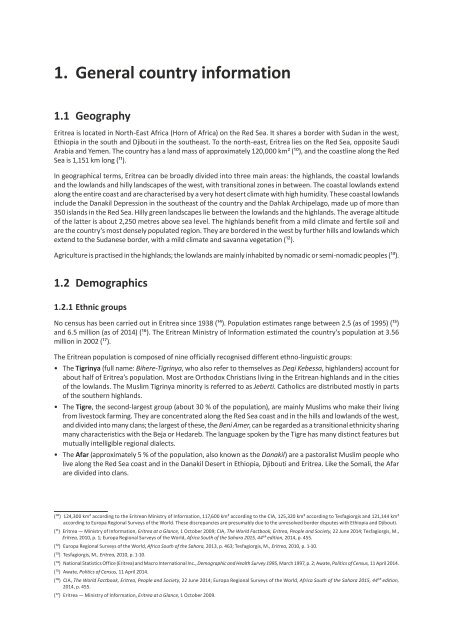You also want an ePaper? Increase the reach of your titles
YUMPU automatically turns print PDFs into web optimized ePapers that Google loves.
1. General country information<br />
1.1 Geography<br />
Eritrea is located in North-East Africa (Horn of Africa) on the Red Sea. It shares a border with Sudan in the west,<br />
Ethiopia in the south and Djibouti in the southeast. To the north-east, Eritrea lies on the Red Sea, opposite Saudi<br />
Arabia and Yemen. The country has a land mass of approximately 120,000 km2 (10), and the coastline along the Red<br />
Sea is 1,151 km long (11).<br />
In geographical terms, Eritrea can be broadly divided into three main areas: the highlands, the coastal lowlands<br />
and the lowlands and hilly landscapes of the west, with transitional zones in between. The coastal lowlands extend<br />
along the entire coast and are characterised by a very hot desert climate with high humidity. These coastal lowlands<br />
include the Danakil Depression in the southeast of the country and the Dahlak Archipelago, made up of more than<br />
350 islands in the Red Sea. Hilly green landscapes lie between the lowlands and the highlands. The average altitude<br />
of the latter is about 2,250 metres above sea level. The highlands benefit from a mild climate and fertile soil and<br />
are the country’s most densely populated region. They are bordered in the west by further hills and lowlands which<br />
extend to the Sudanese border, with a mild climate and savanna vegetation (12).<br />
Agriculture is practised in the highlands; the lowlands are mainly inhabited by nomadic or semi-nomadic peoples (13).<br />
1.2 Demographics<br />
1.2.1 Ethnic groups<br />
No census has been carried out in Eritrea since 1938 (14). Population estimates range between 2.5 (as of 1995) (15)<br />
and 6.5 million (as of 2014) (16). The Eritrean Ministry of Information estimated the country’s population at 3.56<br />
million in 2002 (17).<br />
The Eritrean population is composed of nine officially recognised different ethno-linguistic groups:<br />
• The Tigrinya (full name: Bihere-Tigrinya, who also refer to themselves as Deqi Kebessa, highlanders) account for<br />
about half of Eritrea’s population. Most are Orthodox Christians living in the Eritrean highlands and in the cities<br />
of the lowlands. The Muslim Tigrinya minority is referred to as Je<strong>ber</strong>ti. Catholics are distributed mostly in parts<br />
of the southern highlands.<br />
• The Tigre, the second-largest group (about 30 % of the population), are mainly Muslims who make their living<br />
from livestock farming. They are concentrated along the Red Sea coast and in the hills and lowlands of the west,<br />
and divided into many clans; the largest of these, the Beni Amer, can be regarded as a transitional ethnicity sharing<br />
many characteristics with the Beja or Hedareb. The language spoken by the Tigre has many distinct features but<br />
mutually intelligible regional dialects.<br />
• The Afar (approximately 5 % of the population, also known as the Danakil) are a pastoralist Muslim people who<br />
live along the Red Sea coast and in the Danakil Desert in Ethiopia, Djibouti and Eritrea. Like the Somali, the Afar<br />
are divided into clans.<br />
(10) 124,300 km2 according to the Eritrean Ministry of Information, 117,600 km2 according to the CIA, 125,320 km2 according to Tesfagiorgis and 121,144 km2<br />
according to Europa Regional Surveys of the World. These discrepancies are presumably due to the unresolved border disputes with Ethiopia and Djibouti.<br />
(11) Eritrea — Ministry of Information, Eritrea at a Glance, 1 Octo<strong>ber</strong> 2009; CIA, The World Factbook, Eritrea, People and Society, 22 June 2014; Tesfagiorgis, M.,<br />
Eritrea, 2010, p. 1; Europa Regional Surveys of the World, Africa South of the Sahara 2015, 44th edition, 2014, p. 455.<br />
(12) Europa Regional Surveys of the World, Africa South of the Sahara, 2013, p. 463; Tesfagiorgis, M., Eritrea, 2010, p. 1-10.<br />
(13) Tesfagiorgis, M., Eritrea, 2010, p. 1-10.<br />
(14) National Statistics Office (Eritrea) and Macro International Inc., Demographic and Health Survey 1995, March 1997, p. 2; Awate, Politics of Census, 11 April 2014.<br />
(15) Awate, Politics of Census, 11 April 2014.<br />
(16) CIA, The World Factbook, Eritrea, People and Society, 22 June 2014; Europa Regional Surveys of the World, Africa South of the Sahara 2015, 44th edition,<br />
2014, p. 455.<br />
(17) Eritrea — Ministry of Information, Eritrea at a Glance, 1 Octo<strong>ber</strong> 2009.


